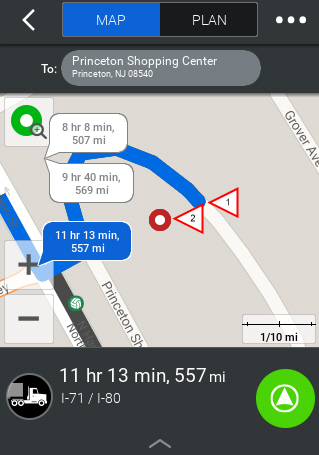The CoPilot routing algorithm looks for the “best” path between two points. However, “best” is subjective—it depends on a user selecting the Route Type and Vehicle Routing Profile that fit his or her business needs.
- The three factors CoPilot considers when creating a best path are total distance, total time to drive it, and appropriateness for the vehicle. (e.g. Larger trucks have fewer challenges on higher class roads which are wider and have fewer sharp turns.)
- The default route type is Practical, also displayed as Quickest. This balances time, distance, and appropriateness for the vehicle type. The other two route types are Shortest, which is the least distance, and Fastest (displayed as "ActiveRoutes"), which is the least time. Please note that optimizing for distance may increase time, and optimizing for time may increase distance. (ActiveRoutes requires an ActiveTraffic license)
- Route Modifiers can be used to generally shape a route path, but do not act as “always avoid” or “always use” attributes—they are more like “avoid this road unless the alternative is too inefficient” flags. (For example, if a stop is on a road marked as an Avoid.) Modifiers can be created for a specific route directly in CoPilot, or as Avoids and Favors created in Content Tools and assigned in CoPilot FleetPortal for use across all routes for a group of vehicles.

What are Stops?
We use the general term “stop” to describe all defined locations in a trip itinerary, avoiding terms like “origin” or “destination” which have a wide range of common uses.
In addition to stops, you can also set Waypoints for a route. Waypoints can be used to modify the route path to pass through a specified point, without acting as a full stop.
The Ways Stops are Entered into CoPilot
There are many ways to define stops in CoPilot, including:
- Current location
- Latitude/longitude coordinates
- Street address
- Recently visited locations or locations saved as Favorites
- Public Points of Interest (POIs) or Custom Places
- Contacts from the device where Copilot is installed
Creating a “Routable Point”
Most methods of entering stops result in a stop point that is technically not on the road network—for example, entering the latitude/longitude of a building. Therefore, CoPilot takes an additional step to create a “routable point” for that stop.
The most common process of creating a routable point for the stop involves our snapping logic. (We “snap” the stop point to the nearest routable road link.) This is why we sometimes refer to the routable point as the “snap point.”
Essentially this creates two points for every stop on a trip:
- The routable point - the point on the road network used by the routing algorithm to create a path (calculation level, invisible to the user).
- The stop point - the original stop lat/long used to display to the user.

For this route, No. 1 is the routable point, and No. 2 is the stop point that was entered into CoPilot.
Legs and Current Location
When the routing algorithm creates a path between two routable points, this is called a “leg.” Trip plans may consist of only one leg—the Current Location to Stop 1—or multiple legs.
- When navigation begins, CoPilot will then monitor only the current leg when providing active guidance. It constantly monitors Current Location, comparing it to the current leg of the trip and the current (upcoming) stop.
- When the vehicle gets close enough to the stop, CoPilot provides the driver with an “Approaching” notification, which gives the stop name and the side of the street.
- CoPilot will reroute if Current Location deviates from the planned route path—essentially generating a brand new route path from Current Location to the stop. Subsequent trip legs are unaffected.
- When the current stop of an active trip is manually cleared by the user, CoPilot moves on to the next leg of the trip. It also almost always results in a recalculation of that next leg’s path, particularly when the Current Location is some distance away from the stop that was cleared.
Other Factors that Impact Routing
In addition to the Route Type and Vehicle Routing Profile, other factors that can impact how CoPilot routes, include:


